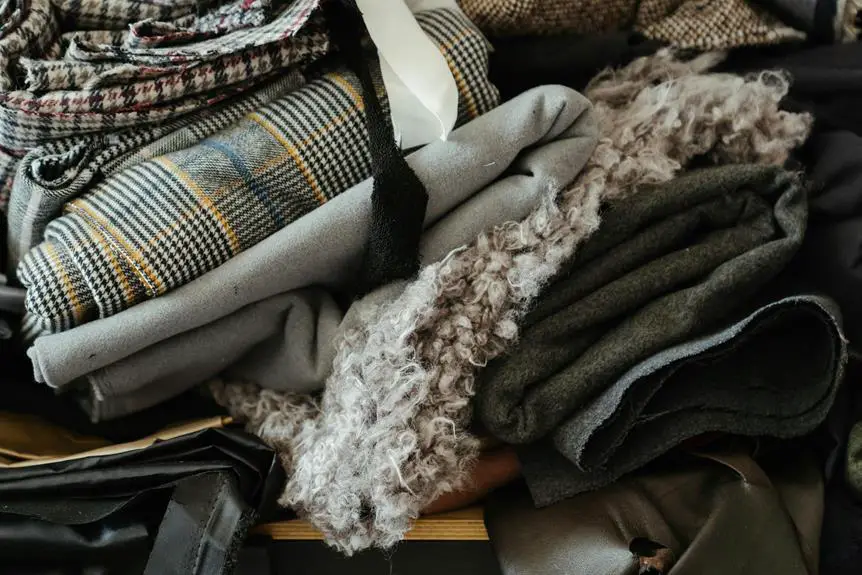When it comes to Madras plaid, you might think all patterns are created equal, but the differences between authentic and imitation can be striking. Authentic Madras is handwoven from fine cotton, showcasing rich cultural heritage and craftsmanship, while imitations often lack this depth and vibrancy. Have you ever noticed how the colors and patterns can tell a story? Understanding these distinctions not only enhances your appreciation but also informs your choices when shopping for this timeless fabric. You'll want to explore what truly sets authentic Madras apart from its imitations.
Table of Contents
History of Madras Plaid
Madras plaid originated in the Indian city of Madras (now Chennai), where artisans crafted vibrant, handwoven fabrics for centuries. You might be surprised to learn that the fabric dates back to the 17th century. It became popular among colonial traders who brought it back to Europe, introducing it to a wider audience.
The unique patterns and bright colors captivated many, leading to its adaptation in various garments and textiles over time. In the 18th century, you'd find Madras plaid adorning the uniforms of British soldiers, reflecting its growing popularity.
With the advent of the 19th century, the fabric was officially introduced into American fashion, often associated with summer wear, particularly in the Southern states.
Characteristics of Authentic Madras
Authentic Madras features vibrant, handwoven patterns that showcase the craftsmanship of artisans, making each piece unique and full of character.
When you touch an authentic piece, you'll feel the rich texture and quality that sets it apart. The colors are often bright and eye-catching, drawing you in with their warmth and energy.
Here are three standout characteristics you can expect:
- Color Variation: Each fabric boasts a kaleidoscope of colors, often blending shades like fiery red, sunny yellow, and deep blue, creating a lively visual experience that captivates the eye.
- Distinct Patterns: Authentic Madras showcases irregular plaid designs, with cross-hatched colors that might shift slightly across the fabric, reminding you of its handmade origins.
- Breathable Fabric: It's crafted from lightweight cotton, allowing for comfort in warm climates while maintaining durability for everyday wear.
These traits not only enhance the aesthetic appeal of Authentic Madras but also reflect the rich cultural heritage behind the fabric.
Investing in authentic pieces means embracing uniqueness and quality, setting your wardrobe apart.
Craftsmanship in Authentic Madras
The intricate craftsmanship behind authentic Madras is what truly brings its vibrant patterns to life, showcasing the skill and dedication of artisans in every thread.
When you wear genuine Madras, you're not just donning a piece of fabric; you're embracing a tradition that spans generations. Artisans in India skillfully weave the fabric using a method called 'handloom,' which allows for a level of intricacy and detail that's hard to replicate.
Each piece of authentic Madras is meticulously hand-printed using a time-honored dyeing technique known as 'block printing,' where intricate wooden blocks are stamped on the fabric. This process ensures that each design is unique, and no two pieces are exactly alike. You'll notice how the colors bleed into one another gracefully, providing a beautiful depth that imitation Madras simply can't match.
Additionally, the artisans pay careful attention to the stitching and finishing techniques, which enhance the garment's durability and overall aesthetic appeal.
When you choose authentic Madras, you're supporting the craftsmanship and artistry that make this fabric a timeless staple. So, appreciate the work behind that vibrant plaid; it's a story of skill, passion, and tradition woven into every garment.
Differences in Fabric Quality
Quality varies significantly between authentic and imitation Madras, with genuine fabric offering a softness and durability that makes it ideal for long-lasting wear. When you choose authentic Madras, you'll immediately notice the difference in feel and performance compared to its imitation counterpart.
Here are three key aspects of fabric quality that set authentic Madras apart:
- Texture: The genuine fabric is often made from fine cotton, giving it a luxurious, buttery smooth texture that feels great against the skin. You can sense the premium quality with every touch.
- Weave: Authentic Madras features a tight, even weave that not only enhances durability but also ensures the fabric holds its shape well over time. This prevents stretching or sagging, making it a wardrobe staple.
- Breathability: Genuine Madras is highly breathable, making it comfortable for wear in warm weather. You'll appreciate how it helps you stay cool and dry, which isn't something you'll experience with cheaper imitations.
Vibrancy of Colors
When you compare authentic and imitation Madras plaid, you'll notice distinct differences in color saturation levels.
Authentic Madras tends to showcase a richer vibrancy, while imitation versions often fall flat.
Additionally, you'll see inconsistencies in the patterns that further highlight these color variations.
Color Saturation Levels
Authentic Madras plaid typically showcases vibrant color saturation, giving it a lively and eye-catching appearance. When you look closely, you'll notice the stunning intensity that sets it apart from imitation options. The colors jump out, creating a feeling of energy and freshness.
Here's how you can visualize the striking color saturation in authentic Madras plaid:
- Bright Coral Red: Imagine the warm hues reflecting the sun, reminiscent of a summer sunset.
- Electric Turquoise: Consider the bold blue-green that nearly pulsates, evoking images of tropical waters.
- Lively Lime Green: Picture the crisp green shades that remind you of vibrant grass underfoot on a bright day.
These rich colors are often the result of traditional dyeing methods, which allow for a depth that imitation Madras can't replicate.
While imitation patterns may look colorful at first glance, they often lack the same lively quality. Instead, their colors might seem flat or dull, ultimately leading to a less authentic experience.
Pattern Consistency Differences
You'll notice significant differences in pattern consistency when comparing authentic Madras plaid to imitation versions, especially in how those vibrant colors come together.
Authentic Madras is known for its rich, lively hues that seamlessly blend throughout the fabric, creating a dynamic look. Each square in the pattern often showcases variations in color intensity, which is a hallmark of genuine craftsmanship.
On the other hand, imitation Madras tends to use a more uniform approach, resulting in colors that appear flatter and less engaging. The consistency of patterns in these fakes often detracts from the overall vibrancy, making the design look artificial. You'll see sharp lines and limited color variations, which lack the depth and liveliness of true Madras plaid.
When you wear or work with authentic Madras, you'll feel the difference immediately. The colors dance together in a way that draws the eye, creating a fabric that's not just decorative but also tells a story of heritage.
Cultural Significance
When you explore the cultural significance of Madras plaid, you'll uncover its rich historical roots that date back to India.
This fabric carries symbolism in fashion trends, reflecting identity and status, while also showcasing regional variations that highlight local artistry.
Understanding these aspects helps you appreciate the depth and diversity of Madras plaid beyond its aesthetic appeal.
Historical Roots of Madras
Tracing its origins back to the vibrant textiles of India, Madras plaid embodies a rich cultural heritage that reflects the region's artisanal craftsmanship and social history. You'll discover that this fabric has roots deep in the traditions of weavers in Tamil Nadu, who developed a unique style blending colors and patterns.
As you delve into its historical significance, consider these three key aspects:
- Colonial Influence: Madras caught the attention of European traders in the 17th century, who sought its intricate designs, leading it to become a sought-after export.
- Cultural Exchange: The introduction of Madras plaid to Western fashion represented a fusion of Eastern and Western aesthetics, symbolizing a connection between different cultures.
- Celebration of Community: For many Indian families, weaving Madras isn't just about fabric; it's a tradition passed down through generations, binding communities together.
Symbolism in Fashion Trends
Madras plaid isn't just a pattern; it symbolizes a rich tapestry of cultural influences and personal expression in the world of fashion. When you wear madras plaid, you're not just making a style statement; you're connecting with a history that spans continents and communities. Originating from India, this textile embodies the spirit of creativity, adaptability, and cultural mixing.
This pattern often signifies leisure and warmth, evoking images of sun-soaked vacations and vibrant outdoor gatherings. As you incorporate madras plaid into your wardrobe, it reflects your appreciation for both tradition and innovation. It's a nod to the artisans who crafted it and the myriad of people who've embraced it through the years.
Wearing madras plaid also communicates a sense of individuality. You might choose bold colors to demonstrate your vibrant personality or softer tones to convey a more understated elegance. Ultimately, it's about how you make this pattern your own, expressing your unique identity while honoring its cultural roots.
In today's world, madras plaid transcends mere fabric; it becomes a symbol of shared experiences and a celebration of diverse fashion narratives.
Regional Variations and Impact
Cultural significance varies widely across regions, and the madras plaid pattern exemplifies this diversity through its distinct adaptations worldwide. Each culture embraces the pattern, weaving its own narrative into the fabric.
For instance, you might notice how it manifests in different ways:
- India: In its birthplace, madras plaid captures vibrant colors and intricate designs, reflecting local artistry and heritage. It's often worn during celebrations and signifies community bonds.
- United States: Here, madras plaid is synonymous with casual summer wear. You may spot it at outdoor gatherings, where it represents a relaxed lifestyle and nostalgia for beachside picnics.
- Caribbean: In this region, madras plaid appears in traditional garments, symbolizing cultural pride and historical significance. It's often featured in festivals, uniting people through color and rhythm.
Identifying Imitation Madras
When examining plaid patterns for authenticity, you'll notice several key features that can help you distinguish imitation Madras from the real thing. First off, take a close look at the fabric. Authentic Madras is typically made from lightweight cotton, while imitation versions often use synthetic blends, which can feel stiff and less breathable.
Next, check the color and pattern. Authentic Madras patterns should have soft, muted colors that have been hand-dyed, resulting in slight variations. On the other hand, imitation fabrics usually exhibit sharper, more uniform lines and often appear overly vibrant due to cheaper dyes.
Here's a quick comparison to help you identify the differences:
| Feature | Authentic Madras |
|---|---|
| Fabric Quality | Lightweight cotton |
| Color Variation | Soft, muted tones |
| Pattern Consistency | Slightly irregular |
Frequently Asked Questions
Can Authentic Madras Plaid Be Machine Washed?
Yes, you can machine wash authentic Madras plaid, but it's best to use a gentle cycle with cold water. Always check the care label first to ensure you're maintaining the fabric's quality and color vibrancy.
How Should I Store Madras Plaid Fabrics?
When storing your madras plaid fabrics, keep them in a cool, dry place. Fold them loosely to avoid creasing, and use breathable storage bags to protect against dust. Avoid plastic, as it can trap moisture.
Is There a Difference in Cost Between Authentic and Imitation Madras?
Yes, there's usually a noticeable difference in cost. Authentic madras tends to be pricier due to superior craftsmanship and quality materials, while imitation madras is more affordable and might compromise on fabric quality and longevity.
Can I Find Authentic Madras Plaid Online?
Yes, you can find authentic Madras plaid online. Look for reputable retailers specializing in Indian textiles or check trusted marketplaces. Be sure to verify product descriptions and reviews to ensure you're getting genuine fabric.
What Are Common Uses for Madras Plaid Beyond Clothing?
You can use madras plaid for home decor, like throw pillows and curtains, or even tablecloths and napkins. It adds a vibrant touch to various settings, making it a great choice for both casual and formal occasions.
- How Does Ring Spun Cotton Affect Garment Fit and Shape Retention? - August 13, 2024
- What Are the Challenges in Producing Ring Spun Cotton? - August 13, 2024
- Is Ring Spun Cotton Suitable for Plus-Size Clothing? - August 13, 2024







